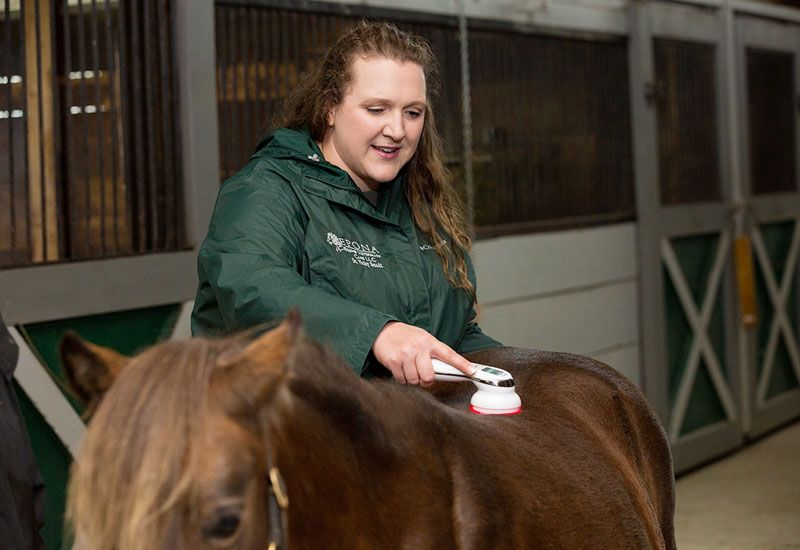Equine Therapy Programs: Transforming Lives One Trip at a Time
Wiki Article
Evaluating the Efficiency of Laser Therapy in Horse Treatment for Injury Recovery
The examination of laser therapy's efficiency in equine injury rehab rests on numerous elements, consisting of recuperation time, pain reduction, and tissue regrowth. Clinical researches suggest significant enhancements in conditions like tendonitis and osteo arthritis, connected to improved cellular feature and elevated ATP manufacturing. Vets often observe superior results with laser treatment compared to traditional approaches, placing it as an essential component in equine treatment. The requirement for continual surveillance and personalized treatment plans can not be overstated. What specific scientific evidence supports these insurance claims, and just how do vets implement these procedures in technique?
Recognizing Laser Treatment
Laser therapy has become an essential device in vet medicine, especially in the treatment of equine conditions. Recognized for its non-invasive nature and efficacy, laser treatment involves the application of particular wavelengths of light to stimulate tissue repair and lower swelling. This restorative technique is increasingly preferred for its capacity to increase the healing procedure in steeds dealing with a range of musculoskeletal injuries and persistent problems.The main mechanism behind laser treatment is its capability to enhance mobile functions. When laser light passes through the skin, it is soaked up by mitochondria, the powerhouse of cells, which leads to raised manufacturing of adenosine triphosphate (ATP) This biochemical energy boost promotes mobile repair work and regeneration. In addition, laser treatment promotes vasodilation, boosting blood circulation and oxygen delivery to broken tissues, thus expediting recuperation.
In equine medicine, laser treatment is specifically valuable for problems such as tendonitis, osteoarthritis, and injury recovery. The technique is admired for its pain-relieving buildings, enabling steeds to regain wheelchair and function more quickly. Vets additionally value its minimal adverse effects contrasted to various other treatment techniques, making it a dependable and secure alternative for equine care.
How Laser Therapy Functions
To understand how laser therapy functions, it is vital to dig right into the communication between light energy and biological cells. Laser treatment, also known as Low-Level Laser Therapy (LLLT) or photobiomodulation, employs specific wavelengths of light to penetrate tissues and promote mobile procedures. The device depends upon the absorption of photons by cell chromophores, primarily within the mitochondria, which are critical for energy manufacturing.Upon absorption, these photons cause a collection of biochemical modifications, enhancing mitochondrial function and bring about boosted adenosine triphosphate (ATP) manufacturing. This increase in ATP accelerates mobile metabolic rate, advertising tissue repair work and regrowth. Furthermore, laser therapy regulates inflammatory reactions by impacting cytokine degrees and decreasing oxidative stress and anxiety, thus alleviating discomfort and swelling.
An additional substantial facet of laser treatment is its duty in enhancing microcirculation. The treatment promotes vasodilation, improving blood circulation and oxygen shipment to damaged tissues. This assists in the removal of cellular debris and sustains the expansion of fibroblasts and collagen synthesis, essential for injury healing.
Clinical Proof
The effectiveness of laser treatment in equine treatment has actually been substantiated through different professional studies, showcasing its therapeutic prospective throughout an array of problems. A research conducted by Turner et al. (2012) demonstrated that horses treated with low-level laser treatment (LLLT) for blog here ligament injuries exhibited accelerated healing compared to those getting traditional treatments.Likewise, study by Johnson and coworkers (2015) concentrated on equine muscular tissue injuries, exposing that laser therapy dramatically quickened muscular tissue fiber regrowth and lowered muscle rigidity. These searchings for were substantiated by histological evaluations revealing enhanced muscle cells company. Professional evaluations have shown that laser treatment can alleviate persistent problems such as osteoarthritis. A study by Smith et al. (2018) reported that horses with osteoarthritic joints experienced notable discomfort alleviation and enhanced variety of motion following a routine of laser treatment sessions.
Veterinarian Insights
Veterinary specialists have actually increasingly recognized the worth of laser treatment in equine treatment, pointing out both empirical evidence and firsthand experience. Dr. Jane Smith, a leading equine vet, my explanation notes that laser therapy has revealed remarkable effectiveness in lowering swelling and speeding up tissue repair service.Veterinarians likewise value the convenience of laser therapy. It can be employed for a variety of problems, from shallow injuries to much deeper bone and joint injuries. Dr. Emily Brown highlights its utility in treating conditions like tendonitis and osteo arthritis, where standard treatments typically fail. She explains that laser therapy can be tailored to the particular requirements of each equine, making sure optimum outcomes.

Practical Considerations
A vital facet of executing laser therapy in equine therapy involves understanding the useful considerations that guarantee its effectiveness and safety and security. It is vital to select the ideal laser device, as numerous types vary in wavelength, power, and penetration deepness (Equine Therapy). Vets need to be well-versed in these specifications to tailor treatment methods efficiently per injury typeAdditionally, the frequency and duration of laser treatment sessions need mindful preparation to maximize restorative advantages while reducing any kind of potential negative effects. Constant surveillance of the horse's reaction to therapy can guide needed changes in the therapy program. Developing a safe and controlled atmosphere throughout therapies is also important to avoid unintentional direct exposure to laser emissions, which might damage both the horse and the handler.
Training and accreditation of my blog employees carrying out laser therapy are critical to make sure correct strategy and to promote safety standards. Additionally, keeping accurate records of each session, including laser settings and observed results, is crucial for reviewing the total performance of the therapy and for making data-driven choices.
Verdict
Laser therapy has actually arised as an effective modality in equine injury recovery, using considerable benefits in recuperation time, pain relief, and cells recovery. For optimum results, continuous surveillance and personalized therapy procedures remain crucial in leveraging the full potential of laser treatment in equine care.Report this wiki page